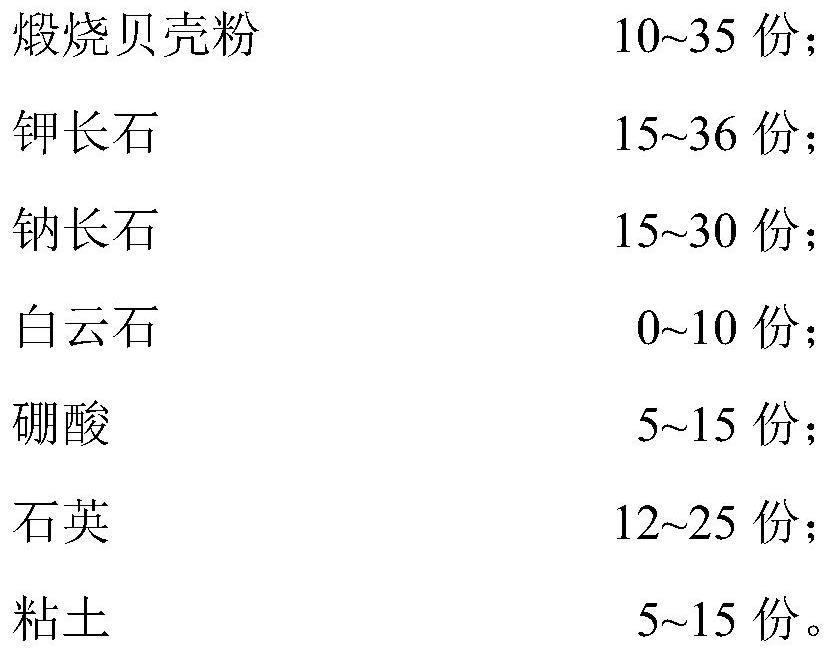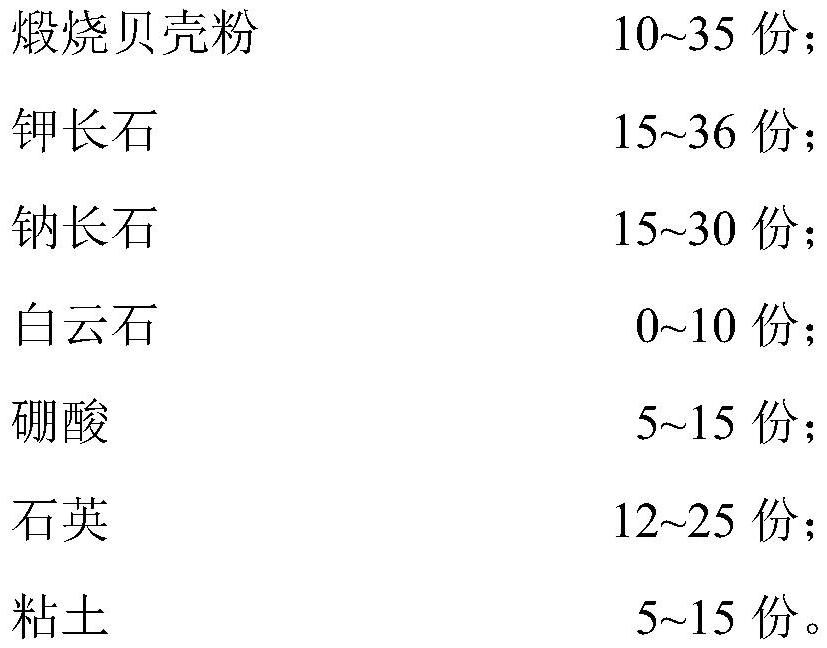Silk- and satin-texture ceramic glaze, preparation method and ceramic rock plate using silk- and satin-texture ceramic glaze
A ceramic glaze and texture technology, which is applied in the field of building ceramic materials, can solve the problems of narrow firing range, single texture of glazed surface, and high production cost, and achieve wide firing range, excellent comprehensive performance of glazed surface, and low production cost. Effect
- Summary
- Abstract
- Description
- Claims
- Application Information
AI Technical Summary
Problems solved by technology
Method used
Image
Examples
Embodiment 1
[0027] A satin texture ceramic glaze is characterized in that it comprises the following components in parts by weight of raw materials:
[0028]
[0029] The preparation method is attached figure 1 Shown:
[0030] 1) Select shells: mix 25 parts of oysters, 25 parts of cockles, 25 parts of meretrix meretrix, and 25 parts of razor clams according to the weight of raw materials, so that the chemical composition of shells before calcination is 0.6 parts of Na 2 O, 0.4 parts of Al 2 o 3 , 0.4 parts of SiO 2 , 55.4 parts of CaO, 0.2 parts of P 2 o 5 , 43 copies of burning loss;
[0031] 2) Calcination: put the shells in step 1) in a furnace, control the temperature rise rate from room temperature to 450°C to 2°C / min, and the temperature rise rate from 450 to 780°C to 5°C / min, and calcined at 780°C After 2 hours, after ball milling and passing through a 250 mesh sieve, calcined shell powder was obtained;
[0032] 3) Glaze making: mix the components evenly according to the w...
Embodiment 2
[0047] A satin texture ceramic glaze is characterized in that it comprises the following components in parts by weight of raw materials:
[0048]
[0049] Preparation:
[0050] 1) Select shells: 50 parts of oysters and 50 parts of mussels are mixed in parts by weight of raw materials, and the chemical composition of the shells before calcination is 0.4 parts of Na 2 O, 0.2 parts of Al 2 o 3 , 0.5 parts of SiO 2 , 55.6 parts of CaO, 0.3 parts of P 2 o 5 , 43 copies of burning loss;
[0051] 2) Calcination: Put the shells from step 1) in a furnace, control the temperature rise rate from room temperature to 450°C to 2°C / min, and the temperature rise rate from 450 to 1000°C to 5°C / min, and calcined at 1000°C After 1 hour, after ball milling and passing through a 250 mesh sieve, calcined shell powder was obtained;
[0052] 3) Mix the components evenly in parts by weight of raw materials, add 0.5 part of modifier and 0.5 part of dispersant, and carry out wet ball milling. ...
Embodiment 3
[0055] A satin texture ceramic glaze is characterized in that it comprises the following components in parts by weight of raw materials:
[0056]
[0057] Preparation:
[0058] 1) Select shells: 75 parts of cockles and 25 parts of meretrix meretrix are mixed in parts by weight of raw materials, and the chemical composition of the shells before calcination is 0.8 parts of Na 2 O, 0.2 parts of Al 2 o 3 , 0.1 parts of SiO 2 , 55.9 parts of CaO, 43 parts of loss on ignition;
[0059] 2) Calcination: put the shells from step 1) in a furnace, control the temperature rise rate from room temperature to 450°C to 2°C / min, and the temperature rise rate from 450 to 850°C to 5°C / min, and calcined at 850°C After 1.5 hours, after ball milling and passing through a 250 mesh sieve, calcined shell powder was obtained;
[0060] 3) Mix the components evenly in parts by weight of raw materials, add 0.3 parts of modifier and 2 parts of dispersant, and perform wet ball milling. After ball mi...
PUM
 Login to View More
Login to View More Abstract
Description
Claims
Application Information
 Login to View More
Login to View More - R&D
- Intellectual Property
- Life Sciences
- Materials
- Tech Scout
- Unparalleled Data Quality
- Higher Quality Content
- 60% Fewer Hallucinations
Browse by: Latest US Patents, China's latest patents, Technical Efficacy Thesaurus, Application Domain, Technology Topic, Popular Technical Reports.
© 2025 PatSnap. All rights reserved.Legal|Privacy policy|Modern Slavery Act Transparency Statement|Sitemap|About US| Contact US: help@patsnap.com



